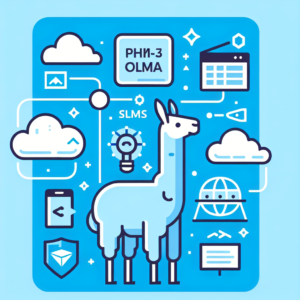Introduction
In the rapidly evolving landscape of artificial intelligence, Microsoft’s PHI-3 stands out as a revolutionary SLM. Designed to enhance various AI applications, PHI-3 promises advancements in natural language processing, machine learning, and data analysis. This blog post delves into how you can get started with Microsoft’s PHI-3 on Ollama, exploring its features, setup, and potential applications.
Understanding SLMs
Small Language Models (SLMs) are essentially downsized versions of their larger LLM counterparts. They boast significantly fewer parameters(it refers to the variables or weights that the model learns during the training process. These parameters are essential for the model to understand and generate human-like text), typically ranging from a few million to several billion, in contrast to LLMs, which can have hundreds of billions or even trillions of parameters. This variation in size brings forth numerous benefits:
- Resource Optimization: SLMs demand less computational power and memory, enabling deployment on smaller devices or in edge computing setups. This facilitates practical applications like on-device chatbots and personalized mobile assistants, enhancing efficiency and accessibility.
- Accessibility and Innovation: With reduced resource demands, SLMs become more accessible to a broader range of developers and organizations. This fosters AI democratization, allowing smaller teams and individual researchers to explore language model potential without significant infrastructure investments, thus promoting innovation and inclusivity.
Understanding PHI-3
PHI-3 is the latest iteration in Microsoft’s AI models, boasting superior performance in text understanding, generation, and contextual analysis. Its capabilities make it ideal for tasks ranging from chatbots and content generation to complex data interpretation.

Recently, the company unveiled the Phi-3 family of open models, boasting the title of the most proficient and economical small language models on the market. These Phi-3 models surpass counterparts of equivalent and larger sizes in various benchmarks assessing language, coding, and math abilities. This achievement is attributed to pioneering training techniques devised by Microsoft researchers. Please click here to know more
Setting Up PHI-3 on Azure
Step 1: Create an Azure Account
- Navigate to the Azure website (azure.com) and sign up for an account if you haven’t already.
- Follow the prompts to complete the account creation process, providing necessary details such as email address, password, and payment information.
- Once your account is set up, log in to the Azure portal using your credentials.
Step 2: Deploy Phi-3 from Azure Marketplace
- In the Azure portal dashboard, locate the “Azure Marketplace” option in the left-hand menu and click on it.
- Search for “Phi-3” in the search bar at the top of the Marketplace page.
- Select the Phi-3 offering that best suits your needs and click on it to view more details.
- Review the pricing and deployment options, then click “Create” to begin the deployment process.
- Follow the prompts to configure the deployment settings, such as region, resource group, and pricing tier.
- Once configured, click “Review + Create” to validate your settings, then click “Create” to initiate the deployment.
- Wait for the deployment to complete. This may take a few minutes.
Step 3: Access Phi-3 APIs
- Once the deployment is successful, navigate to the resource group where Phi-3 was deployed.
- Find the Phi-3 resource in the resource list and click on it to open the resource dashboard.
- In the Phi-3 dashboard, locate the API endpoints for accessing Phi-3’s natural language processing capabilities.
- Make note of the API endpoints and any authentication tokens or keys required to access them.
Step 4: Integrate Phi-3 into Your Applications
- Use the provided API endpoints and authentication credentials to integrate Phi-3 into your applications or workflows.
- Follow the documentation and tutorials available on the Azure website to learn how to make API calls, process text data, and interpret the results returned by Phi-3.
- Experiment with Phi-3’s features and capabilities to understand its full potential for natural language processing tasks.
Setting Up PHI-3 on Ollama
Ollama is an open-source project that provides a powerful and user-friendly platform for running LLMs on your local machine. Here’s a step-by-step guide to getting started:
- Create an Ollama Account: Begin by signing up on the Ollama platform. This will grant you access to the necessary tools and resources.
- Access the PHI-3 Model: Navigate to the model library and select PHI-3. Ensure you have the required permissions and resources allocated. You can also access the model from Hugging Chat.
- Environment Configuration: Set up your development environment according to the guidelines provided by Ollama. This involves configuring dependencies and setting up API access.
- Model Integration: Integrate PHI-3 into your applications. Use the API documentation to seamlessly embed PHI-3 capabilities within your software.
- Testing and Deployment: Rigorously test the integrated model in a controlled environment. Once satisfied with its performance, deploy it to your production environment.
Benefits and Applications
Enhanced NLP Capabilities: PHI-3 excels in understanding and generating human-like text, making it ideal for advanced chatbots and virtual assistants.
Scalability: Thanks to Ollama’s infrastructure, scaling your applications with PHI-3 is straightforward, ensuring high performance even under heavy loads.
Versatility: Whether you’re working on sentiment analysis, automated content creation, or data-driven decision-making, PHI-3 provides robust solutions tailored to various needs.
Conclusion
Microsoft’s PHI-3 opens up new possibilities for businesses and developers looking to leverage cutting-edge AI technology. By following the setup guide and exploring its applications, you can harness the full potential of PHI-3 to drive innovation and efficiency in your projects.


Leave a Reply